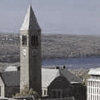Center for Applied Mathematics Colloquium
Material science has been rapidly developing in recent years. A variety of particles interacting according to different kinds of pair potentials has been produced in experimental works. Looking into the future, one can imagine controlled self-assembly of particles into clusters of desired structures leading to the creation of new types of materials. Analytical studies of the self-assembly involve coping with difficulties associated with the huge numbers configurations, high dimensionality, complex geometry, and unacceptably large CPU times.
A feasible approach to the study of self-assembly consists of mapping the collections of clusters onto stochastic networks (continuous-time Markov chains) and analyzing their dynamics. Vertices of the networks represent local minima of the potential energy of the clusters, while arcs connect only those pairs of vertices that correspond to local minima between which direct transitions are physically possible. Transition rates along the arcs are the transition rates between the corresponding pairs of local minima. Such networks are mathematically tractable and, at the same time, preserve important features of the underlying dynamics. Nevertheless, their huge size and complexity render their analysis challenging and invoke the development of new mathematical techniques. I will discuss some approaches to construction and analysis of such networks.
